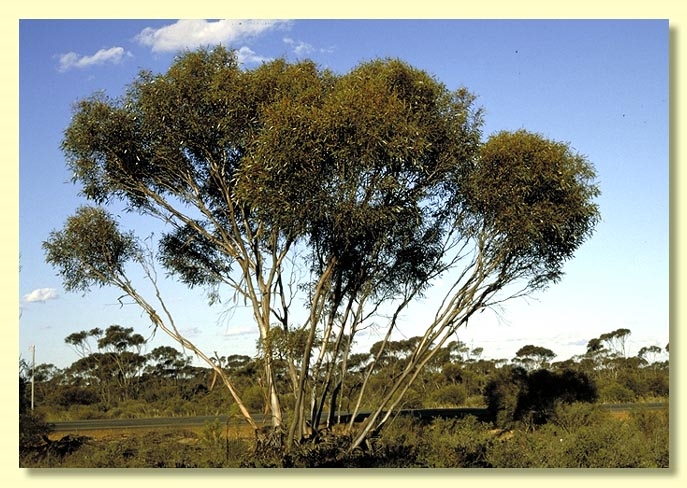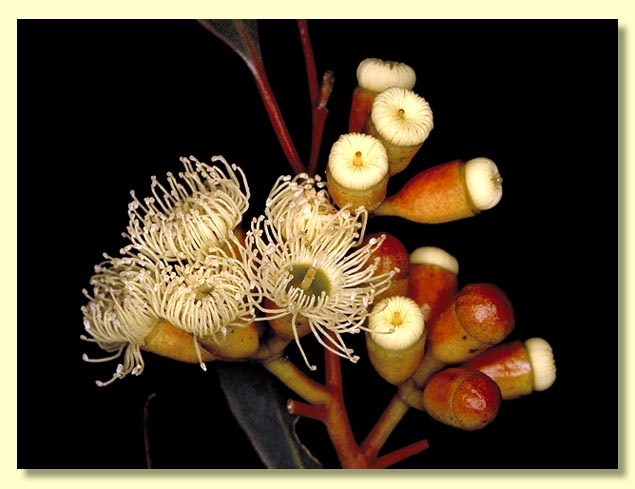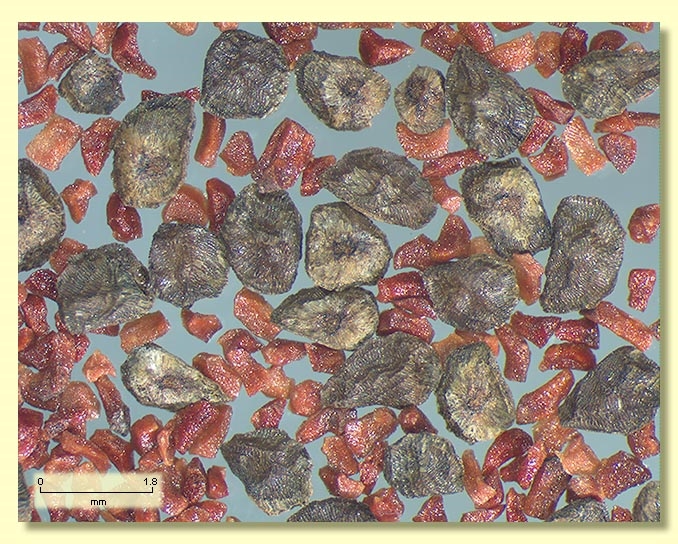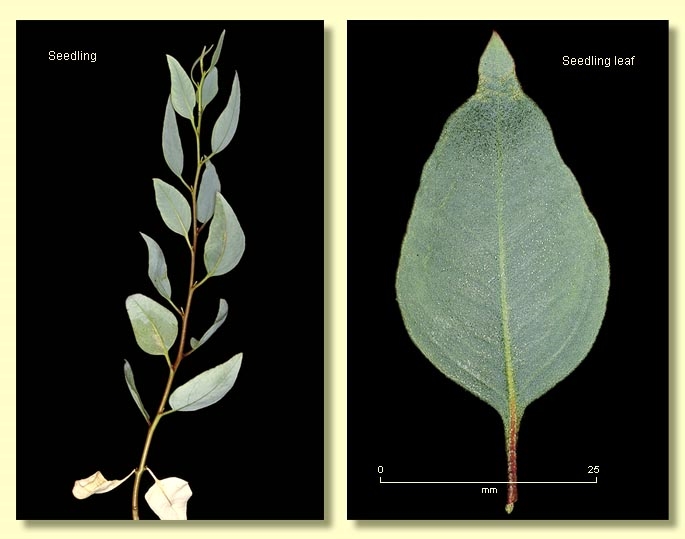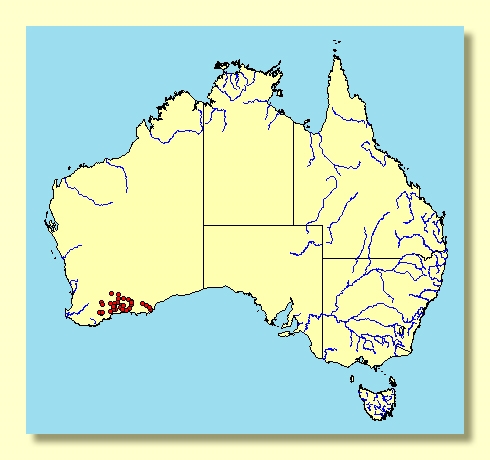Eucalyptus | Symphyomyrtus | Dumaria | Furfuraceae
Euclid - Online edition
Eucalyptus sp. Southern Wheatbelt
Eucalyptus sp. Southern Wheatbelt (D.Nicolle & M.French DN 5507), D.Nicolle, M.E.French & K.R.Thiele (2012), Nuytsia 22(3) 107-108.
Western Australia: Mallee Rd, N of Reserve Rd [E of Lake Magenta], 23 Mar. 2010, D. Nicolle 5507 & M. French (PERTH).
This species was incorrectly referred to as Eucalyptus scyphocalyx (F.Muell. ex Benth.) Maiden & Blakely in earlier editions of EUCLID – see penultimate paragraph in the Notes below.
[misapplied name and type specimen: Eucalyptus scyphocalyx (F.Muell. ex Benth.) Maiden & Blakely Crit. Revis. Eucalyptus 8: 45 (1929).
E. dumosa var. scyphocalyx F.Muell. ex Benth., Fl. Austral. 3: 230 (1867). T: Eyre's Relief Camp, W.A., G.Maxwell s.n.; lectotype: K.; isolectotype: MEL.; note that the MEL specimen has a pencil note added later stating collection date "June 1863"; note also that Maiden states "collector not known"]
Bark wholly smooth, pale orangey brown and grey, when trees up to 2 m of basal rough persistent ribbons present.
Branchlets have oil glands in the pith.
Juvenile growth (coppice or field seedlings to 50 cm): stems rounded in cross-section; juvenile leaves always petiolate, alternate, lanceolate, 5–8.5 cm long, 1–2 cm wide, dull, green to grey-green.
Adult leaves alternate, petioles 0.8–2.3 cm long; blade usually lanceolate, 5.5–10.5 cm long, 0.9–2.2 cm wide (ratio of length: width ranges from 4:1 to 8:1), thickish, base tapering to petiole, margin entire, apex pointed, concolorous, dull maturing glossy, green to greyish green, side-veins at an acute or wider angle to midrib, reticulation very dense, intramarginal vein more or less close to margin, oil glands mostly intersectional. Inflorescence axillary unbranched, peduncles 0.3–1.6 cm long, buds (?7)9 to 13, shortly pedicellate, pedicels 0.2–0.5 cm long. Mature buds stoutly cylindrical tending to pyriform at maturity (0.7–1.3 cm long, 0.4–0.7 cm wide), scar present, operculum shallowly flattened to hemispherical or broadly conical (0.2–0.5 cm long), smooth or scarcely striate, stamens inflexed, anthers cuboid, versatile, dorsifixed, dehiscing by longitudinal slits, style long and straight, stigma blunt to rounded, locules (4)5(6), the placentae each with 4 vertical rows of ovules. Flowers creamy white.
Fruit subsessile to shortly pedicellate (pedicels 0.1–0.5 cm long), cupular to cylindrical, smooth to slightly ribbed longitudinally, 0.6–1.1 cm long, 0.7–0.9 cm wide, disc descending vertically, valves (4)5(6), enclosed.
Seeds black-brown with a paler scurfy area on the ventral side around the hilum, rarely extending to dorsal surface, 1.8–3.2 mm long, flattened-ovoid, dorsal surface shallowly reticulate, narrow partial flange often present, hilum ventral.
Cultivated seedlings (measured at ca node 10): cotyledons reniform; stems rounded to square in cross-section; leaves always petiolate, opposite for 3 to 5 nodes then alternate, ovate to almost deltoid, 3.5–8 cm long, 1.8–5.5 cm wide, dull, green to grey-green.
Flowering has been recorded in April, September, October and November.
A mallee endemic to Western Australia, of coastal and subcoastal distribution from Ongerup in the west to north-east of Esperance. The basal bark is rough on larger plants but smooth in small mallees. The adult leaves are at first dull, blue-grey and mature to glossy green.
The unpublished species Eucalyptus sp. Southern Wheatbelt belongs in Eucalyptus subgenus Symphyomyrtus section Dumaria because the buds have two opercula, stamens are strongly inflexed, ovules are in four rows on the placentae and cotyledons are reniform. Within this subgroup E. sp. Southern Wheatbelt is closely related to only two other species—E. leptocalyx and E. platycorys—the three species forming series Furfuraceae. All have flattened grey-brown seeds that have a pale scurfy patch on the underside and have branchlets with oil glands in the pith.
E. sp. Southern Wheatbelt is most likely to be confused with E. leptocalyx as distributions tend to overlap. It can be distinguished by the buds which are shorter and cylindrical-pyriform (quite cylindrical in E. leptocalyx) and cupular-cylindrical fruit that tend to be wider than the more barrel-shaped fruit of E. leptocalyx. E. platycorys has a more inland distribution than E. sp. Southern Wheatbelt and E. leptocalyx, and is rough-barked on the trunk and has buds in umbels of 3(7) (usually >7 to 15 in the other two species).
The type specimen of the name formerly used, Eucalyptus scyphocalyx (F.Muell. ex Benth.) Maiden & Blakely, was collected by G. Maxwell from near ?Rossiter Bay (the general area of Cape Arid) and is of uncertain application in the field. It consists of adult leaves and mature flower-buds. The leaves have consistently shorter petioles and narrower lamina relative to length than is the case with any specimens of E. sp. Southern Wheatbelt, (or of E. surgens Brooker & Hopper). The lack of seeds with the Eucalyptus scyphocalyx type specimens precludes certainty in stating its identity with respect to existing field populations of these two species. The seeds of E. sp. Southern Wheatbelt are flattened ovoid grey-brown with a pale scurfy patch around the hilum but are un-pitted; those of E. surgens are dark brown flattened ovoid conspicuously pitted and ornamented.
Eucalyptus scyphocalyx subsp. triadica (see K.D. Hill et al, 2001) is here regarded as part of E. platycorys and is included in synonymy under that 3(7)-budded species. The type specimen of E. scyphocalyx subsp. triadica is from the southern part of the range of E. platycorys and has immature fruit which may account for them being slightly smaller than is usual.
The name Eucalyptus sp. Southern Wheatbelt reflects the natural distribution of this undescribed species.

